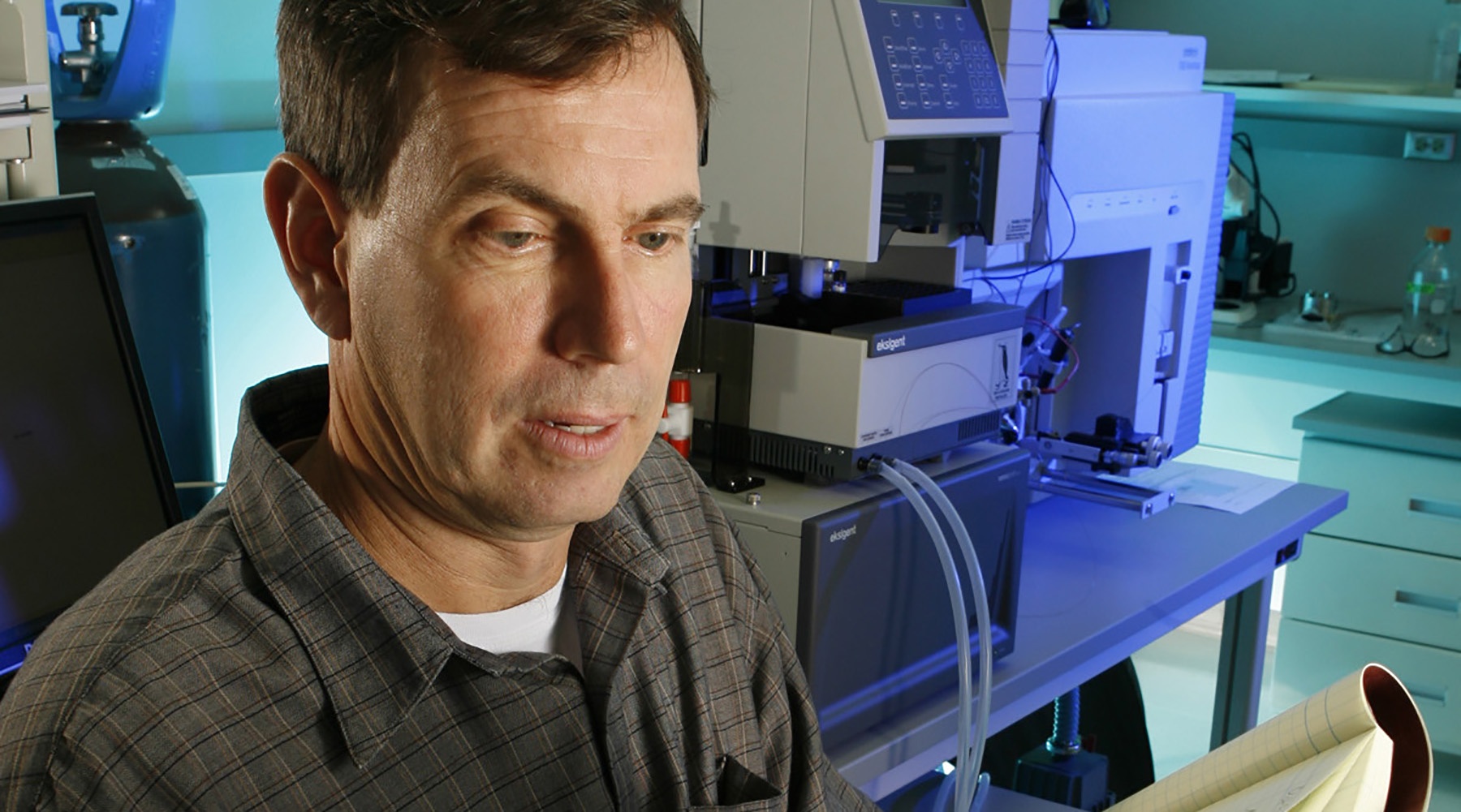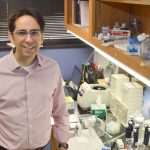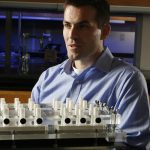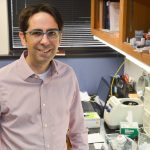Michael T. Kinter, Ph.D.
Associate Professor
Aging & Metabolism Research Program
My 101
Free radicals are formed when the body uses oxygen to make energy, to process foreign particles, like drugs, even when we encounter sunlight or radiation. Sometimes, when free radicals react with the body’s tissues, damage can occur, leading to heart disease, cancer and many conditions associated with aging.
In my lab, we study the damage that happens when free radicals interact with cells and try to observe how cells protect themselves or change themselves in the process. We have learned that sometimes the body’s reaction to the free radicals, rather than the free radicals themselves, can cause the most damage.
Some cells have the ability to adjust to free radical damage and function normally, or even benefit from the interaction. Other cells see little or no damage from free radicals, while some simply shut down or die.
In heart disease, certain white blood cells often react to free radicals by transforming themselves into “foam” cells. Those cells can lead to atherosclerosis, an inflammatory disease that clogs blood vessels and causes heart disease.
Our goal is to understand these changes so we can use them to our benefit. By identifying the triggers that can either increase good cell responses or decrease bad ones, we may learn ways to prevent many kinds of human disease.
Research
There are two primary activities in my laboratory: characterizing changes in protein expression in hearts and mitochondria from mice that are consuming a high-fat diet and characterizing the sites and chemical structure of oxidant-damaged proteins. A unique aspect of my experiments is the use of mass spectrometry to sequence and characterize proteins. These types of experiments are broadly referred to a proteomics.
In the first area of investigation, we use a proteomic approach – gel electrophoresis and quantitative mass spectrometry – to identify proteins that are differentially expressed in the heart and mitochondria. The general hypothesis being tested in this work is that the high fat diet produces a chronic oxidative stress that alters heart and mitochondrial function through changes in protein expression. Our goal is to discover previously unidentified or unstudied proteins that help drive the progression of the diet-induced heart failure.
In the second area of investigation, we use tandem mass spectrometry to characterize the site and structure of oxidative modifications to proteins. One theory of how oxidative stress affects cells is that key proteins become modified in a manner that alters their function. Our goal is to trace the specific structures that are characterized to new information about the oxidation reactions leading to those modifications and the link between those modifications and cell/tissue damage.
Brief CV
Education
B.S. Chemistry, James Madison University, Harrisonburg, VA, 1982
Ph.D. Chemistry, University of North Carolina at Chapel Hill, Chapel Hill, NC, 1986
Postdoc, Clinical Chemistry, University of Virginia, Charlottesville, VA, 1986-1988
Memberships
American Society for Mass Spectrometry
American Society for Biochemistry and Molecular Biology
Society for Free Radical Biology and Medicine
Joined OMRF scientific staff in 2008
Publications
Recent Publications
Deberneh HM, Taylor ME, Kobak KA, Kinter MT, Miller BF, Sadygov RG. Duplexing metabolic deuterated water-labeled samples using dimethyl labeling to estimate protein turnover rates. Commun Chem 8:375, 2025 November, PMID: 41298887, PMCID: PMC12658016
Gray J, Halemirle G, Ferrán B, Rose H, Redwine TL, Pham S, Hagy B, Pranay A, Giorgione J, Hussong SA, Galvan V, Humphries K, Van Remmen H, Kinter M, Sonntag WE, Singh PK, Díaz-García CM. Mitochondrial Ca(2 ) uniporter haploinsufficiency leads to sexually dimorphic redox imbalance and metabolic remodelling in the mouse brain. J Physiol, 2025 October, PMID: 41066222
Ali SR, Nguyen NUN, Elhelaly W, Hsu CC, Li S, Menendez-Montes I, Wang Z, Cui M, Elnwasany A, Xiao F, Sun J, Thet S, Lam NT, Cardoso A, Pereira AH, Wang J, Olson EN, Kinter MT, Szweda LI, Shelton J, Kimura W, Sadek HA. Paracrine IGFBP3 spatially coordinates IGF signaling to induce myocardial regeneration in mice. J Mol Cell Cardiol, 2025 August, PMID: 40829695, PMCID: PMC12532329
Selected Publications
Fu Y, Kinter M, Hudson J, Humphries KM, Lane RS, White JR, Hakim M, Pan Y, Verdin E, Griffin TM. Aging Promotes SIRT3-dependent Cartilage SOD2 Acetylation and Osteoarthritis. Arthritis Rheumatol. 2016 Aug;68(8):1887-98. PMID: 26866626 PMCID: PMC5331855
Walsh ME, Bhattacharya A, Sataranatarajan K, Qaisar R, Sloane L, Rahman MM, Kinter M, Van Remmen H. The histone deacetylase inhibitor butyrate improves metabolism and reduces muscle atrophy during aging. Aging Cell 2015 Dec; 14(6): 957–970. PMID: 26290460 PMCID: PMC4693467
Fernandes J, Weddle A, Kinter CS, Humphries KM, Mather T, Szweda LI, Kinter M. Lysine acetylation activates mitochondrial aconitase in the heart. Biochemistry 2015 Jun 30;54(25):4008-18. PMID: 26061789 PMCID: PMC4513942
Kinter CS, Lundie JM, Patel H, Rindler PM, Szweda LI, Kinter M. A Quantitative proteomic profile of the Nrf2-mediated antioxidant response of macrophages to oxidized LDL determined by multiplexed selected reaction monitoring. PLoS One 7:e50016, 2012. PMID: 23166812 PMCID: PMC3500347
Rindler PM, Plafker SM, Szweda LI, Kinter M. High dietary fat selectively increases catalase expression within cardiac mitochondria. J Biol Chem 288:1979-1990, 2013. PMID: 23204527 PMCID: PMC3548505
Conway JP, Kinter M. Proteomic and transcriptomic analyses of macrophages with an increased resistance to oxidized low density lipoprotein (oxLDL)-induced cytotoxicity generated by chronic exposure to oxLDL. Mol Cell Proteomics 4:1522-1540, 2005. PMID: 16006650
Contact
Aging & Metabolism Research Program, MS 46
Oklahoma Medical Research Foundation
825 N.E. 13th Street
Oklahoma City, OK 73104
Phone: (405) 271-7572
Fax: (405) 271-1437
E-mail: Mike-Kinter@omrf.org
For media inquiries, please contact OMRF’s Office of Public Affairs at news@omrf.org.
Lab Staff
Brooke Loveland
Research Technician II
Holly Smith
Administrative Assistant III
News from the Kinter lab
A new wave of researchers has joined the Oklahoma Medical Research Foundation’s scientific staff as part of the foundation’s expansion. OMRF has added seven new scientists to its staff. In addition, two research assistants have been promoted to faculty-level positions. The new researchers have come to OMRF from a variety of institutions across the U.S. […]



















